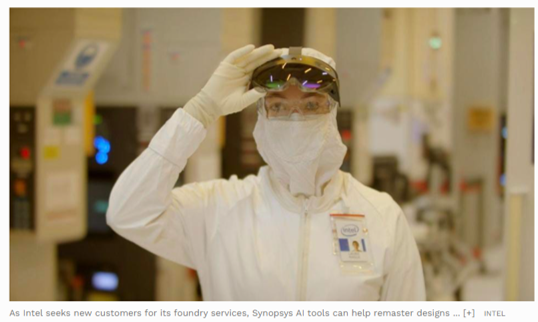K
Kathleen Martin
Guest
In part, yes. We could tap into unused manufacturing capacity using AI, and Synopsys believes it has the AI that could do it.
Today’s chip shortage is holding back global economic growth, fueling inflation, and making life difficult for consumers and businesses alike. Everything from ovens to Porsches are affected. The causes are complex, but one of the aspects is that the shortfall in manufacturing capacity is uneven, affecting legacy process nodes far more than mid-performance nodes such as 12 and 16nm, where there is a surplus. Yes, even though Apple, Intel, Qualcomm, and NVIDIA push the envelope to produce chips in the most advanced process nodes, the US Department of Commerce says 8-10% (20-25 million wafers) of total global fab capacity goes unused annually. Until now, investing in retargeting older chips to available capacity just hasn’t made economic sense. Things may be changing...
Re-balancing Capacity and Demand
As Intel CEO Pat Gelsinger recently noted, “The inability to transition nodes efficiently and quickly means that capacity remains unused. Since building new fabs on old nodes doesn’t make techonomic sense, to mitigate the supply issue, the path forward is moving designs between nodes”.
As Intel seeks new customers for its foundry services, Synopsys AI tools can help remaster designs to soak up excess capacity.
However, moving designs from node to node, or “retargeting,” is impractical. Scarce engineering resources are busy designing new silicon, which drives future revenue and profits, so retargeting projects are a lower priority. To make things worse, retargeting, in most cases, is almost as complex as designing a chip, to begin with. But now, AI may offer a path forward, enabling companies to refresh silicon quickly and affordably, producing new, faster chips, lower power, and less expensive than what is in the field today. Synopsys has years of experience with using AI in chip design, and is now taking the next step.
Silicon Remastering
Synopsys refers to this as “Silicon Remastering”: the use of AI algorithms to automatically redesign a chip for a different node, achieving months or years of work in just weeks while potentially saving customers hundreds of millions of dollars. Company co-founder and co-CEO Aart de Geuss discussed this capability in his keynote address at the annual ISSCC conference, explaining that this approach could mitigate supply issues in relatively short order by bringing 25 million new wafers online or more than a year’s worth of new capacity. “Within five years, we will see a transformation of the global chip supply chain that will better facilitate the use of capacity, and we believe silicon remastering will be critical technology,” Dr. de Geus said.
Continue reading: https://www.forbes.com/sites/karlfreund/2022/02/21/could-ai-help-solve-the-global-chip-shortage/?sh=40234e9cc42f
Today’s chip shortage is holding back global economic growth, fueling inflation, and making life difficult for consumers and businesses alike. Everything from ovens to Porsches are affected. The causes are complex, but one of the aspects is that the shortfall in manufacturing capacity is uneven, affecting legacy process nodes far more than mid-performance nodes such as 12 and 16nm, where there is a surplus. Yes, even though Apple, Intel, Qualcomm, and NVIDIA push the envelope to produce chips in the most advanced process nodes, the US Department of Commerce says 8-10% (20-25 million wafers) of total global fab capacity goes unused annually. Until now, investing in retargeting older chips to available capacity just hasn’t made economic sense. Things may be changing...
Re-balancing Capacity and Demand
As Intel CEO Pat Gelsinger recently noted, “The inability to transition nodes efficiently and quickly means that capacity remains unused. Since building new fabs on old nodes doesn’t make techonomic sense, to mitigate the supply issue, the path forward is moving designs between nodes”.
As Intel seeks new customers for its foundry services, Synopsys AI tools can help remaster designs to soak up excess capacity.
However, moving designs from node to node, or “retargeting,” is impractical. Scarce engineering resources are busy designing new silicon, which drives future revenue and profits, so retargeting projects are a lower priority. To make things worse, retargeting, in most cases, is almost as complex as designing a chip, to begin with. But now, AI may offer a path forward, enabling companies to refresh silicon quickly and affordably, producing new, faster chips, lower power, and less expensive than what is in the field today. Synopsys has years of experience with using AI in chip design, and is now taking the next step.
Silicon Remastering
Synopsys refers to this as “Silicon Remastering”: the use of AI algorithms to automatically redesign a chip for a different node, achieving months or years of work in just weeks while potentially saving customers hundreds of millions of dollars. Company co-founder and co-CEO Aart de Geuss discussed this capability in his keynote address at the annual ISSCC conference, explaining that this approach could mitigate supply issues in relatively short order by bringing 25 million new wafers online or more than a year’s worth of new capacity. “Within five years, we will see a transformation of the global chip supply chain that will better facilitate the use of capacity, and we believe silicon remastering will be critical technology,” Dr. de Geus said.
Continue reading: https://www.forbes.com/sites/karlfreund/2022/02/21/could-ai-help-solve-the-global-chip-shortage/?sh=40234e9cc42f

